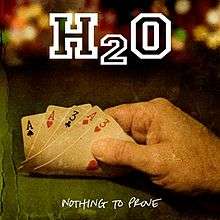Nothing to Prove (H2O album)
Nothing to Prove is the fifth studio album by punk rock band H2O.[1] It was released on May 27, 2008, through Bridge 9 Records.[2] It is the band's first album since 2001's Go, and the first new material since their 2002 EP All We Want. The album hit at #7 on Billboard Top Heatseekers on June 14, 2008.
| Nothing to Prove | ||||
|---|---|---|---|---|
 | ||||
| Studio album by | ||||
| Released | May 27, 2008 | |||
| Recorded | January 7-January 9th & through January 2008 | |||
| Genre | Punk rock | |||
| Label | Bridge 9 Records | |||
| Producer | Chad Gilbert | |||
| H2O chronology | ||||
| ||||
| Review scores | |
|---|---|
| Source | Rating |
| AbsolutePunk.net | 82% link |
| Allmusic | |
| AsIce.net | |
| Unglued Reviews | |
Toby Morse's son Maximus is featured throughout the album, providing intros/outros to many of the songs.
Track listing
| No. | Title | Length |
|---|---|---|
| 1. | "1995" | 2:34 |
| 2. | "Nothing To Prove" | 1:21 |
| 3. | "Sunday" | 2:59 |
| 4. | "A Thin Line" | 2:05 |
| 5. | "Unconditional" | 2:34 |
| 6. | "Still Here" | 1:53 |
| 7. | "Fairweather Friend" | 2:23 |
| 8. | "Heart On My Sleeve" | 2:11 |
| 9. | "Mitts" | 2:42 |
| 10. | "What Happened?" | 2:53 |
| Total length: | 23:35 | |
Notes
The track "Mitts" is a reworked version of the songs "Static", which appeared on their 2002 EP All We Want. The band produced a video for "What Happened" featuring actor Michael Rapaport and musicians Matt Skiba and Lou Koller.
Personnel
- Toby Morse – vocals
- Todd Morse – guitar, vocals
- Rusty Pistachio – guitar, vocals
- Adam Blake – bass
- Todd Friend – drums
- Roger Miret – vocals on "Nothing to Prove"
- Freddy Cricien – vocals on "A Thin Line"
- CIV – guests on "Still Here"
- Lou Koller – guest on "Fairweather Friend" and "What Happened"
- Kevin Seconds – guest on "Fairweather Friend"
- Matt Skiba – guest on "What Happened"
- Danny Diablo – guest on "Nothing to Prove"
- Sons of Nero – artwork
gollark: I guess it's possible that even one which doesn't know about parties might accidentally be biased due to (hypothetically, I don't know if this is true) one party being popular in low-density areas and the other in high-density, or really any other difference in locations.
gollark: You don't actually need simple shapes very badly as long as you have an algorithm which is not likely to be biased.
gollark: Okay, rearrange the states so they're square.
gollark: A simple if slightly inaccurate way would be some kind of binary space partitioning thing, where (pretending the US is a perfect square) you just repeatedly divide it in half (alternatingly vertically/horizontally), but stop dividing a particular subregion when population goes below some target number.
gollark: The more complex the algorithm the more people might try and manipulate it. The obvious* solution is to just split up the country by latitude/longitude grid squares.
This article is issued from Wikipedia. The text is licensed under Creative Commons - Attribution - Sharealike. Additional terms may apply for the media files.